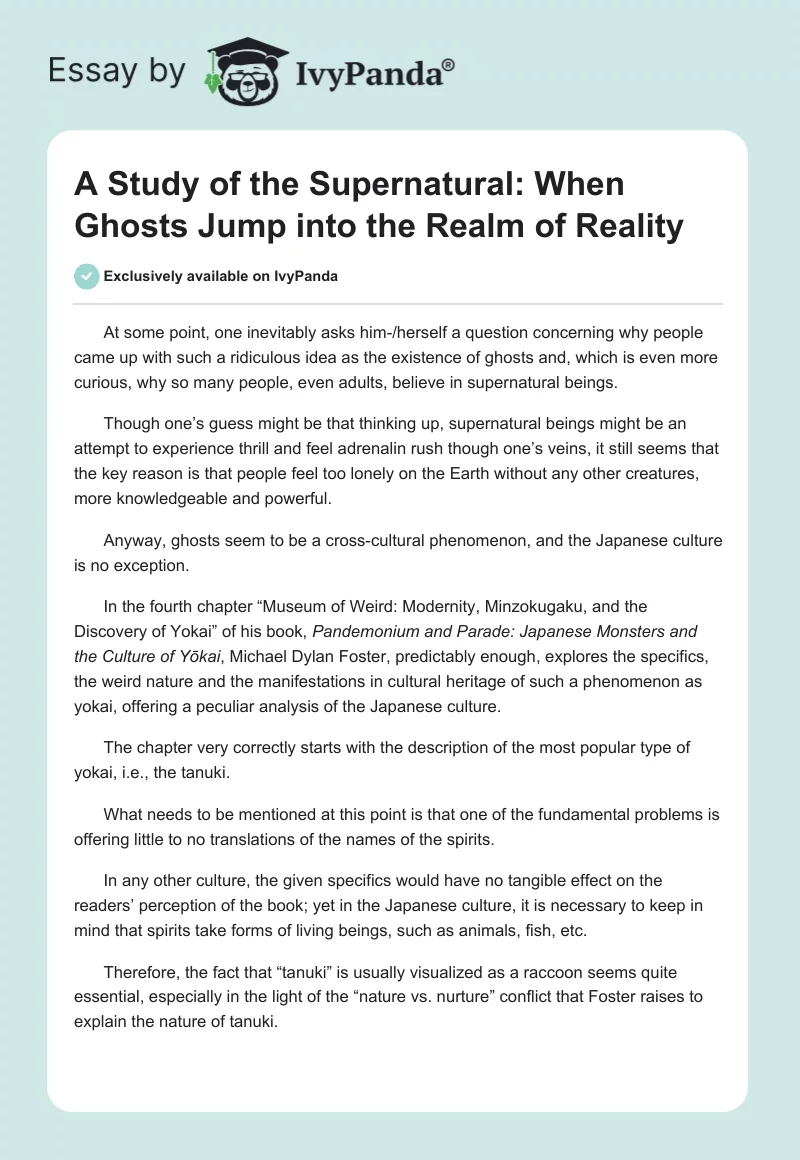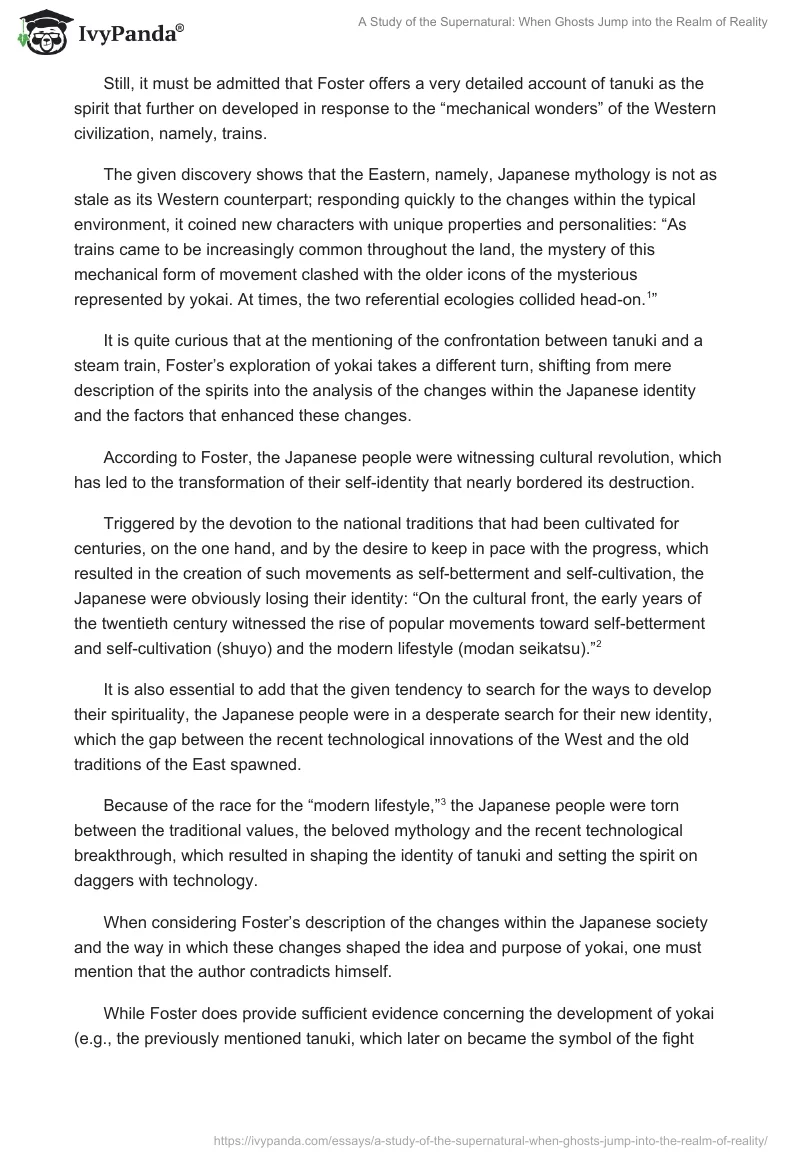At some point, one inevitably asks him-/herself a question concerning why people came up with such a ridiculous idea as the existence of ghosts and, which is even more curious, why so many people, even adults, believe in supernatural beings.
Though one’s guess might be that thinking up, supernatural beings might be an attempt to experience thrill and feel adrenalin rush though one’s veins, it still seems that the key reason is that people feel too lonely on the Earth without any other creatures, more knowledgeable and powerful.
Anyway, ghosts seem to be a cross-cultural phenomenon, and the Japanese culture is no exception.
In the fourth chapter “Museum of Weird: Modernity, Minzokugaku, and the Discovery of Yokai” of his book, Pandemonium and Parade: Japanese Monsters and the Culture of Yōkai, Michael Dylan Foster, predictably enough, explores the specifics, the weird nature and the manifestations in cultural heritage of such a phenomenon as yokai, offering a peculiar analysis of the Japanese culture.
The chapter very correctly starts with the description of the most popular type of yokai, i.e., the tanuki.
What needs to be mentioned at this point is that one of the fundamental problems is offering little to no translations of the names of the spirits.
In any other culture, the given specifics would have no tangible effect on the readers’ perception of the book; yet in the Japanese culture, it is necessary to keep in mind that spirits take forms of living beings, such as animals, fish, etc.
Therefore, the fact that “tanuki” is usually visualized as a raccoon seems quite essential, especially in the light of the “nature vs. nurture” conflict that Foster raises to explain the nature of tanuki.
Still, it must be admitted that Foster offers a very detailed account of tanuki as the spirit that further on developed in response to the “mechanical wonders” of the Western civilization, namely, trains.
The given discovery shows that the Eastern, namely, Japanese mythology is not as stale as its Western counterpart; responding quickly to the changes within the typical environment, it coined new characters with unique properties and personalities: “As trains came to be increasingly common throughout the land, the mystery of this mechanical form of movement clashed with the older icons of the mysterious represented by yokai. At times, the two referential ecologies collided head-on.”
It is quite curious that at the mentioning of the confrontation between tanuki and a steam train, Foster’s exploration of yokai takes a different turn, shifting from mere description of the spirits into the analysis of the changes within the Japanese identity and the factors that enhanced these changes.
According to Foster, the Japanese people were witnessing cultural revolution, which has led to the transformation of their self-identity that nearly bordered its destruction.
Triggered by the devotion to the national traditions that had been cultivated for centuries, on the one hand, and by the desire to keep in pace with the progress, which resulted in the creation of such movements as self-betterment and self-cultivation, the Japanese were obviously losing their identity: “On the cultural front, the early years of the twentieth century witnessed the rise of popular movements toward self-betterment and self-cultivation (shuyo) and the modern lifestyle (modan seikatsu).”
It is also essential to add that the given tendency to search for the ways to develop their spirituality, the Japanese people were in a desperate search for their new identity, which the gap between the recent technological innovations of the West and the old traditions of the East spawned.
Because of the race for the “modern lifestyle,” the Japanese people were torn between the traditional values, the beloved mythology and the recent technological breakthrough, which resulted in shaping the identity of tanuki and setting the spirit on daggers with technology.
When considering Foster’s description of the changes within the Japanese society and the way in which these changes shaped the idea and purpose of yokai, one must mention that the author contradicts himself.
While Foster does provide sufficient evidence concerning the development of yokai (e.g., the previously mentioned tanuki, which later on became the symbol of the fight between traditions and progress), he also admits the decay of the yokai: “[…] a dead tanuki rotting by the train tracks”.
A minor nitpick might it seem at first, the given issue can lead the readers to a dreadful conclusion that the Japanese culture in general and the mythology of yokai, in particular, could be at death’s door, since it was considered “an embarrassing reminder of the premodern past”.
However, it seems that Foster merely tries to show that the crisis in the Japanese culture and the interpretation of the yokai has partially lent its specifics to the intellectual divorce between the Japanese mythology and the technological breakthrough: “For their part, yokai were characterized as a construct of the past”.
Therefore, it is clear that the essential peculiarity of the given chapter in Foster’s work is the analysis of change in perception of yokai over centuries, together with the analysis of change in the Japanese perception of self and its influence on the development of yokai.
Making it clear that the analysis of yokai would have been incomplete without considering its appearance in the works of the most time-honored writers in the history of Japanese mythology, Natsume Soseki and Mori Ogai, Foster, however, makes another step backward in his research, since he restricts his choice to only two figures in the Japanese mythological writing, though admittedly influential ones.
To make the matters even more confusing, Foster explains that none of the above-mentioned authors “is particularly famous for treating yokai-related themes”. However, according to Foster, the choice of the historical pieces of evidence to analyze is predetermined by the subtexts within the works by these authors.
To be more exact, the underlying messages in Natsume Soseki and Mori Ogai’s works refute the regress of yokai as a cultural element and “betray a troubling anxiety about the issues that we have been dealing with”.
In his analysis of Natsume Soseki’s “Koto No Sorane,” i.e., “Empty Sounds,” and Mori Ogai’s Hollow Laughter, Foster makes it clear that the significance of yokai has not grown lesser; however, the very attitude towards the spirit and everything that it represents has become different from the traditional interpretation of yokai.
While Natsume Soseki tends to offer the readers a more flippant image of the spirit Mori Ogai creates a disconcerting picture of the spirit, introducing a sexualized subplot into his story.
Thus, offering the readers two different perspectives on the issue, the authors, nevertheless, create two separate parts of a single idea of yokai.
While keeping its natural relation to nature, this new yokai., however, loses its harmlessness, as well as the idea of contrasting with the technological innovations and growing, instead, a petrifying “’ero-guro-nansensu’ (erotic-grotesque-nonsense)” skin.
Thus, Foster leads the readers to his final nonetheless crucial discovery concerning the development of yokai over time. The changes within the very nature of yokai could be an attempt to come to terms with the European and American cultures that were gradually introduced into the Japanese art world.
Making a supposition that Ogai makes an allusion to Ibsen’s Ghost in his work, Foster shows that the Japanese culture was witnessing a radical change in identity, and that the given change touched upon the Japanese mythology in the first place.
Once a spirit that represented certain human qualities, yokai became the symbol of the attempts of the Japanese people to come to terms with the rapid pace of the technological development and at the same time the effort to preserve their identity in the chase for the advances that this development had to offer.
An extremely engaging and very thorough exploration of yokai, the mysterious spirit in the Japanese culture, makes Foster’s book complete.
Indeed, without the description of one of the famous and referred to by far the most significant amount of times in not only Japanese but also European and American papers with the Japanese created a world of supernatural beings as a subject matter, Foster’s research would have been incomplete.
Offering a very honest account of the existing cultural references, as well as the current source materials with yokai as the main character, Foster allows European and American dwellers to sneak a peek at some of the most recognizable Japanese folklore characters and learn their history.
Reference List
Foster, Michael Dylan. “Museum of Weird: Modernity, Minzokugaku, and the Discovery of Yokai.” In Pandemonium and Parade: Japanese Monsters and the Culture of Yōkai, 115–159. Berkeley, CA: University of California Press.


